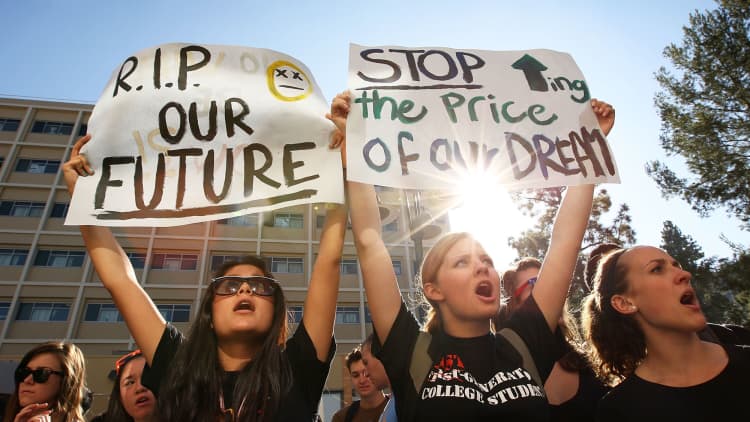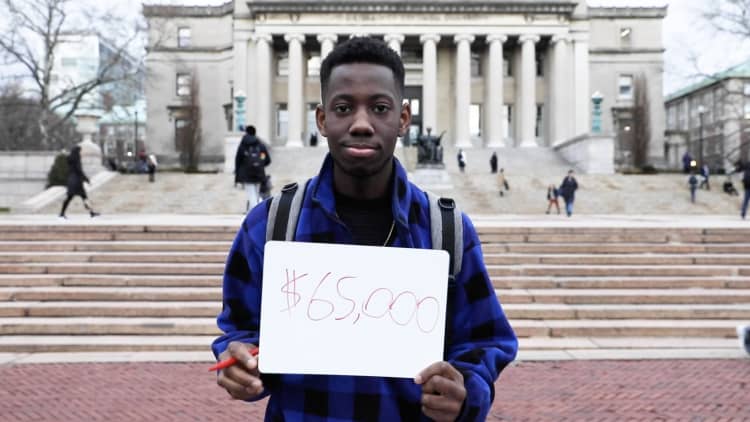In the United States, nearly six million people, about 1 out of 4 college students, attend a community college.
On the campaign trail and in office, President Biden has proposed making two years of community college tuition-free. His American Families Plan includes $200 billion for free universal pre-school, $85 billion for Pell Grants to increase the maximum grant by $1,400, and $109 billion to make two years of community college tuition-free "so that every student has the ability to obtain a degree or certificate."
The College Board estimates that during the 2020-2021 school year, the average annual tuition and fees was $3,700 for in-district students at community colleges, $10,560 for in-state students at public four-year colleges and $37,650 for students at private nonprofit four-year colleges.
Advocates say Biden's proposal could save community college students money and give other students the chance to cut down on college costs by transferring to a traditional four-year college after their first two years. Others are skeptical it will make a significant impact.
CNBC Make It spoke with experts about what the policy would cost — and save — Americans.
The true cost of tuition
"As the conservative in this space, I'm supposed to be outraged by the idea of socializing the two-year sector of higher education," says Beth Akers, senior fellow at the American Enterprise Institute and a staff economist at the Council of Economic Advisers under President George W. Bush. "But the reality is that this shift that he is proposing is not as dramatic as the rhetoric around it would have you believe."
She points out that the majority of community college students qualify for federal and state grants and scholarships.
"Right now, the majority of low-income students already go to community college for free, because of the combination of state aid and federal grants, their net cost, on average, is actually negative, meaning they're getting some money back to cover living expenses," she says. "So the idea that we'll make community college tuition-free, sounds dramatic, but it's not actually a huge change in the logistics of how we're funding post-secondary."
According to The College Board, the average net cost of tuition and fees (after scholarships and grants are considered) at two-year community colleges is actually -$220. This means many community college students are getting a small surplus, though not close to enough to cover books, supplies and living expenses. The estimated total net cost of attendance at community colleges is $14,560, on average.
For this reason, Akers is skeptical of how impactful a tuition-free community college policy would be.
"It probably won't move the needle a whole lot," she says. "The piece that is often missing in this discussion is that generally, cost of living is more of a barrier for students to enroll in college than tuition itself."
Potential wage increases
Anthony Carnavale, director of the Georgetown Center on Education and the Workforce, however, says the plan to eliminate tuition for two years of community college is key for increasing access to higher-paying jobs.
"It's necessary," he says, mentioning maintaining labor competitiveness with countries like Germany and Japan. "Two years of community college brings a return. In general, we see an 8% percent wage increase per annum for every year of college you complete. So if you go to a two-year college, on average, we're talking about a substantial wage increase over a lifetime."
Carnavale, who was appointed by President George W. Bush to serve on the White House Commission on Technology and Adult Education and was appointed by President Clinton to Chair the National Commission on Employment Policy, argues that Biden has picked a pragmatic approach by proposing both two years of free pre-school and two additional years of free community college.
"It's a sweet spot because he wasn't going to get free [four-year] college," he says, referencing college affordability proposals from other Democrats. "He still added four years of education, just like Hillary and Bernie and Elizabeth and all the rest of them proposed, but he put two at the front end and two at the back end. That's really creative and we know from the data that the impact of that will be very strong if it happens. The other thing is that in the end, it costs way less money than [fully] free college."

Transferring troubles
If the policy is passed, Carnavale says its success will hinge on transparency about the kinds of jobs community college programs can prepare students for and how easily students are able to transfer their community college credits to four-year schools.
"Someone's got to figure out strong transfer policies that ensure that there's access to the BA… Everybody keeps talking about training and that's a good idea, too. But the real job growth is coming among BAs," he says.
Aaron Rasmussen, co-founder of Masterclass and CEO of Outlier.org says transferring community college credits from Diablo Valley College in Pleasant Hill, California towards his bachelor's degree at Boston University was key to his ability to graduate — and ultimately, his professional success.
"I remember feeling a stigma about it when I was at BU, but I also didn't have a choice," he says. "My dad was a middle school science teacher and there are seven people in my family. There weren't a lot of options."
He adds that a community college color mixing class he recreationally took at Santa Monica College after graduation informed how he designed the look of Masterclass.
Now an employer, he says he sees great potential for businesses to partner with local community colleges and says he hopes a tuition-free community college policy will eliminate any remaining stigma.
"I think there's an incredible opportunity in front of us."
Don't miss:



